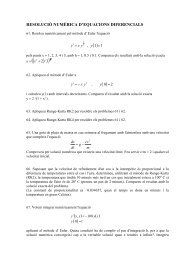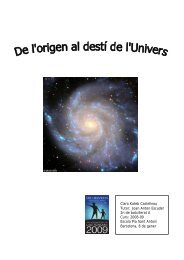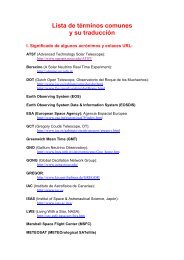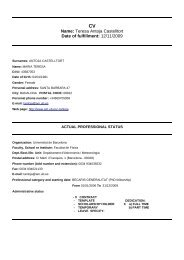Universitat de - Departament d'Astronomia i Meteorologia ...
Universitat de - Departament d'Astronomia i Meteorologia ...
Universitat de - Departament d'Astronomia i Meteorologia ...
You also want an ePaper? Increase the reach of your titles
YUMPU automatically turns print PDFs into web optimized ePapers that Google loves.
4.2. Cross-i<strong>de</strong>ntification between RBSC and NVSS catalogs 125<br />
the Group 2 sample.<br />
When we started this project in 1998 another source fullfiled all the selection<br />
criteria. Now we have performed the cross-i<strong>de</strong>ntification process again, in or<strong>de</strong>r to<br />
present here an updated version of it, and we have found that this source, namely<br />
1RXS J072418.3−071508, was i<strong>de</strong>ntified by Perlman et al. (1998) as a quasar<br />
(WGA J0724.3−0715 in their paper and listed as PMN J0724−0715 in the NED<br />
database). Although it is clear that it is not any more a REXB candidate, we have<br />
preferred to inclu<strong>de</strong> it in the list and present the observational results obtained up<br />
to now in the following chapters. Since the corresponding offset in position for this<br />
object is less than 1σ, it is inclu<strong>de</strong>d in Group 1.<br />
All the sources belonging to Group 1 (a total of 8), Group 2 (a total of 5)<br />
and the already known REXBs are listed in Table 4.1, where Cols. 1 to 4 contain<br />
the RBSC names (which also provi<strong>de</strong> the positions), the 1σ errors in position, the<br />
count rates, and HR1. In Col. 5 we show the offsets between the RBSC and the<br />
NVSS positions. In Cols. 6 to 8 we list the NVSS names (which provi<strong>de</strong> a limited<br />
position information), the 1σ errors in position and the NVSS flux <strong>de</strong>nsities (at<br />
20 cm wavelength). Finally, galactic coordinates for all sources are listed in Cols. 9<br />
and 10. The horizontal line divi<strong>de</strong>s the two groups of sources and the already known<br />
REXBs.<br />
Here we will focus on the Group 1 sources, while Group 2 sources will be eventu-<br />
ally studied in the future. In or<strong>de</strong>r to have a look at the targets, we show in Fig. 4.2,<br />
for each source of Group 1, the NVSS radio contours overlaid on 6 ′ ×6 ′ optical DSS1<br />
images. To mark the RBSC positions we have plotted as open crosses the 3σ errors<br />
in position, allowing a better display than if we had plotted the 1σ errors.<br />
As can be seen in Table 4.1, the NVSS errors are much smaller than the RBSC<br />
ones. Hence, the radio positions are more accurate than the X-ray ones to look<br />
for optical counterparts. An inspection of the DSS1 images in Fig. 4.2 reveals that<br />
some candidates have an optical counterpart approximately in the middle of the<br />
radio contours, while others do not. This is un<strong>de</strong>rstandable because of the low<br />
galactic latitu<strong>de</strong> of these objects, which implies a high <strong>de</strong>gree of extinction along<br />
the line of sight. On the other hand, crow<strong>de</strong>d fields near the galactic plane also<br />
prevent us to be sure about the counterparts <strong>de</strong>tected. Therefore, the next step of<br />
the process is to obtain accurate radio positions and then search for possible optical<br />
counterparts, which is presented in the next chapter.






